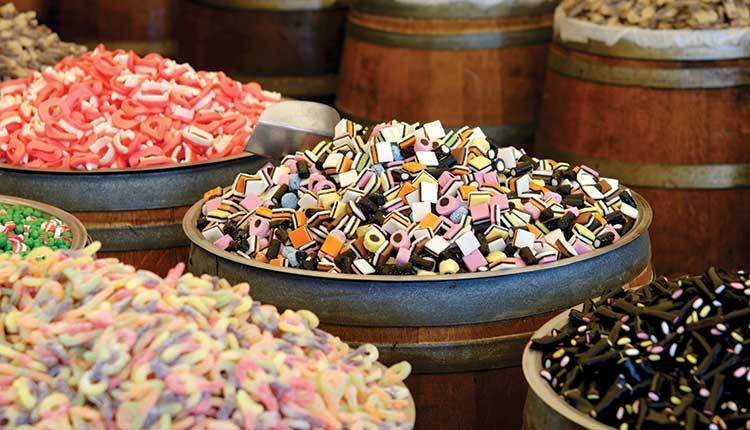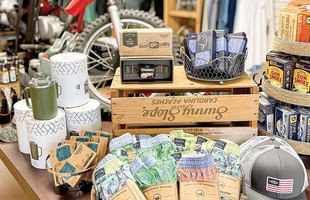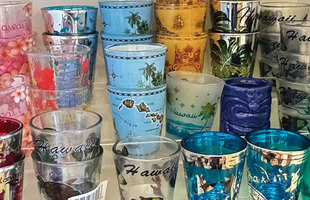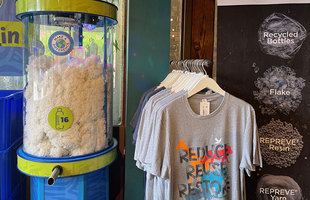As tourists browse the dozens of shops and restaurants of Olde Mistick Village in the coastal town of Mystic, Connecticut, some might be drawn to Franklin’s General Store for its wide assortment of merchandise and products.
Owner Jim Holley boasts that Franklin’s offers over 10,000 different gifts and souvenirs in the 3,250-square-foot storefront.
But what draws in the most revenue for the shop is the retailer’s unique fudge and souvenir candy offerings. Holley estimates fudge accounts for about 27% of the store’s annual sales, while souvenir candy sales make up about 10% of its annual sales.
“We produce fresh fudge daily,” says Holley. “We make anywhere from 300 to 500 pounds in a day.”
Holley adds the fudge counter is closer to the front of the store not far from the registers so it’s easily accessible to customers. Souvenir candy isn’t far off from the fudge counter, either.
“Placement is critical of any product you’re merchandising, be it a toy or specialty food,” he explains. “Where you put something can impact your sales dramatically.”
Although souvenir candy and fudge may be impulse buys, these can be top-selling products for destination retailers if merchandised properly. Lance Stier, head of mergers and acquisitions and business development at Hicksville, New York-based Nassau Candy, explains that tourists love trying new things and that souvenir candy can be a great opportunity for them to offer something unique to the area.
“Traveling is all about trying new things and indulging,” Stier says. “Having your candy assortment embody this adventurous spirit is a great differentiating point.”
At Franklin’s General Store, Holley doesn’t hide his top-selling products like fudge and candy in the back of the store.
“It should be fairly central but closer to the front of the store than the back, that way people know they can get to it quickly,” Holley says. “At Franklin’s, we want to make sure they can’t miss the fudge department.”
Stocked and varied
Offering a wide assortment of candy flavors and types ensures that a destination retailer’s souvenir candy department will appeal to a variety of customers coming to the store. Holley notes that this approach has worked well over the years.
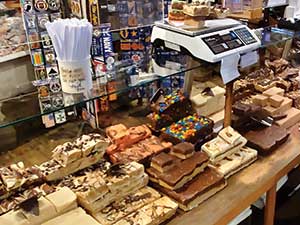
Fudge and candy are prominently placed at Franklin’s General Store.
He adds it’s important to keep the souvenir candy and fudge department fully stocked, even during the slower seasons.
“We don’t want empty space,” says Holley. “When it’s empty, it sets a bad example. It’s better to have products there for when the customer comes in.”
Up north in Mackinaw City, Michigan, Teysen’s Gift Shop has a similar philosophy on stocking souvenir candy and fudge. The destination retailer is also known for its wide selection of fudge and souvenir taffy for people visiting the lakeside town.
“The more you make it look like you’re doing good business with a product and have enough variety, keep your display full, that helps,” says Vicki Teysen, owner of Teysen’s Gift Shop.
A nod to nostalgia
Nostalgic, old fashioned candy varieties and flavors are a souvenir candy trend that doesn’t seem to be going out of style any time soon.
“For the second year in a row, nostalgia and nostalgic flavors have been a top food trend,” notes Stier. “There are many longtime discontinued candy brands that are making a comeback but are still rare and hard to find in the typical retailer. This is a great opportunity to be a key differentiator. Not only do nostalgic candies bring excitement, but many have unique, old-time labels with retro-style imagery creating really fun and vibrant merchandise displays.”
Fort Cody Trading Post has found success with this trend. The business has served as a roadside attraction with a variety of folk art and Buffalo Bill displays and large souvenir store in North Platte, Nebraska, since the mid-1960s. Owner Nick Henline says the shop has had a lot of success when it comes to selling old-
fashioned, nostalgic candies, such as candy cigarettes, Neccos and rock candy.
The retailer makes sure it uses more old-fashioned displays and containers to pair with the nostalgic products. Henline says the store uses mostly wooden barrels for souvenir candy as well as some display tables.
“With the candy, we’re trying to emulate the general store vibe that customers would find decades and decades ago,” he says.
Adding some flavor
Freeze-dried candies also can help a retailer’s candy department stand apart. Stier explains that freeze drying removes moisture from candies, causing them to expand and deliver a light, crispy texture. He says Nassau Candy carries several lines of freeze-dried confections.
“What was once gooey and chewy is now crispy,” Stier explains of freeze-dried candies. “Hard candy that you couldn’t bite through now is like an airy cloud. The flavors also get intense. So creating a display of a variety of freeze-dried items can help draw attention.”

Fudge and candy are prominently placed at Franklin’s General Store.
Vince Cotroneo, president of Ontario- based Marvin Candies and Displays, suggests retailers also have fun with their candy departments by allowing customers to build their own bags to take home. He says that some popular flavors worth featuring at these types of stations include blue raspberry, watermelon, cherry and cola.
He adds that some popular candy types for these stations include Pucker Powder, crunchy candies and gummy candies.
“Interactivity is popular and profitable,” he says. “Being able to create your personal favorite bag or tube of candy is hard to beat.”
Perfecting the details
Many tourists plan to bring home souvenir candy or fudge as gifts for loved ones, so destination retailers can’t skimp on displays and packaging with these souvenirs.
Cotroneo explains that customized islands can be a great vehicle to create a statement for various candy categories in a shop, such as bulk candy, lollipops, taffy, Pucker Powder units or packaged candies and novelties.
He adds that retailers should also consider featuring happy, colorful signage to draw customers to souvenir candy to “reflect the theme of the location.”
Stier says destination retailers also might want to work with souvenir candy wholesalers to design packaging specific for their location. “For gifting, presentation is key with destination-specific art adorning tins, gift boxes, acetate tubs and peg bags,” he explains.
Regardless of the container, the art on the packaging helps to sell the candy. Stier says retailers can get creative by offering candy packaged in other merchandise like drinkware that features destination-specific artware.
Talk it up
In addition to displays and packaging, retailers should encourage employees to help them boost sales of their souvenir candy. One way to do that is by encouraging employees to offer samples of locally made candies or fudges.
Teysen says her team often invites customers to try the store’s fudge as soon as they walk in the door. She also encourages employees to make the fudge during normal business hours so customers can smell it being made.
“I say to make it when it’s busy since if customers smell it, they’ll buy it,” says Teysen.
She also likes to offer fudge coupons at nearby tourist spots, such as hotels or the local visitor center, to draw more people to the store.
At Franklin’s General Store, Holley pays his employees commission for going the extra mile when they sell fudge to customers.
“When you give people incentive for doing a better job, it works. It ups their pay and keeps repeat customers coming back to us.”
At the end of the day, customer service sells and can help destination retailers boost candy sales if that’s a focus for them.
“When somebody comes into a store like ours, they’re there to enjoy themselves,” says Holley. “The best thing you can do is engage with them. That breaks down barriers. People open up. When they see friendliness and caring, it’s the biggest difference between selling and not selling. Make the customer feel special. I always tell staff the same thing. If you get exceptional service, you remember it.”
